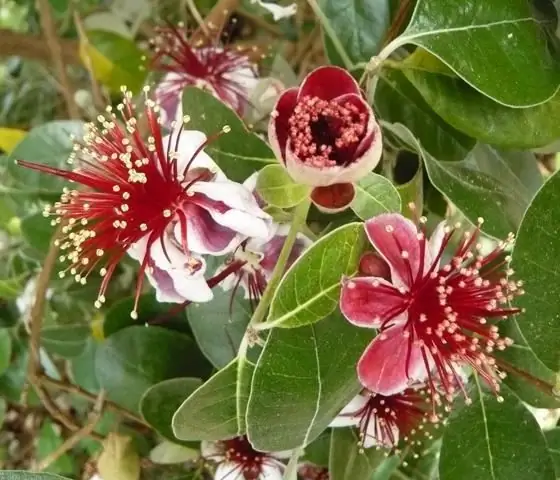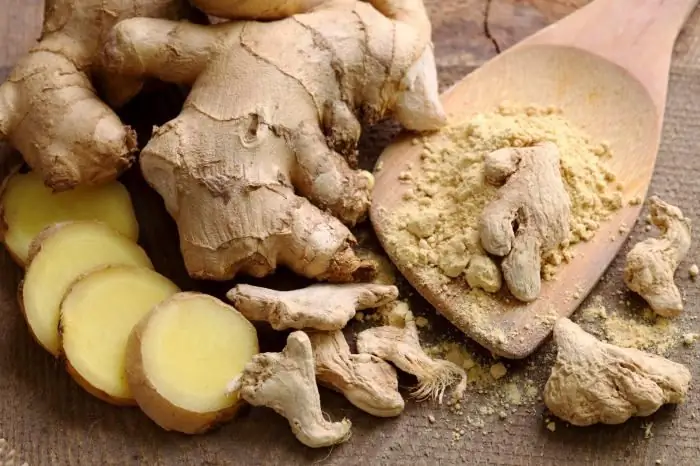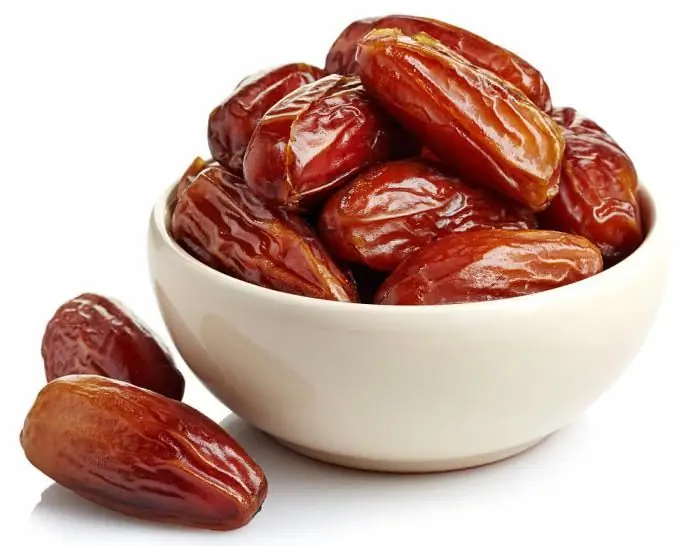2026 Author: Isabella Gilson | [email protected]. Last modified: 2025-01-23 12:50:33
No festive table is complete without juicy and fragrant parsley leaves. But, in fact, the scope of this product is much wider. What beneficial properties of parsley for the body should everyone know about? What parts of this plant can be used? You will find answers to these and other questions in our article.
Parsley: useful properties
This product has been known to people since ancient times. Translated from Greek, its name translates as "growing on the rocks." Initially, parsley was used in cooking. This spicy herb improves the taste and visual qualities of many dishes. But the high content of vitamins, minerals and plant fibers make it an indispensable tool for normalizing the activity of many organ systems. Consider the beneficial properties and contraindications of parsley in more detail.

Systematics and biological description
Parsley, the beneficial properties of which we study in our article,is a typical representative of dicotyledonous plants of the Umbelliferae family. This biennial herb is easily recognizable by its characteristic leaves. They are dark green in color and lustrous. Leaf blades are triangular in shape, doubly pinnatisected. They are located on a low erect stem.
In the first year, the plant does not bloom. Parsley has a thickened main root that stores water and nutrients. Thanks to this reserve, the plant tolerates cold, and by the middle of next summer, the first inflorescences appear. Their type is a complex umbrella. Small flowers are white or yellow. As a result, fruits are formed - bipartite achenes.
Applications
Traditionally, fresh leaves are considered to be the most valuable part of this plant. But that's not the case at all. Both parsley seeds and roots have useful properties. How can these parts be used? Cooks add chopped parsley root to fish dishes and sauces. This gives them a tart and spicy taste. Essential oils are obtained from greens and fruits, which are used in canning.
Already in the 17th century, recipes for medicinal preparations from parsley were known. They were used as a diuretic and anti-inflammatory agent, treatment of diseases of the kidneys and liver.

Chemical composition
The beneficial properties of parsley are due to the diversity of its organic and mineral components. The first group is carbohydrates and proteins. Of the macronutrients, the most valuable are iron, magnesium, potassium,calcium and phosphorus. This plant is rich in vitamins. First of all, it is ascorbic and nicotinic acids, retinol and thiamine.
The characteristic taste of different parts of parsley is given by essential oils. Most of them are found in fruits and fresh leaves. The main substance of the oil is called apiol, or parsley camphor. Scientists have proven that it has chemoprotective properties - it stops the growth of cancer cells.

Healing Root
Parsley has a modified underground part. It's called a root crop. On the Mediterranean coast and in European countries, parsley root is eaten. And you can eat it both fresh and boiled. A lot of essential oils are found in the peel of the root, so it is best to wash it before cooking with a soft brush. This product is cooked very quickly - it will be ready in five minutes after boiling water. And for the winter, you can prepare a powder from a medicinal root. To do this, the root crop will need to be crushed, dried, and only then grind. Such preparation can be added to soups, meat dishes, fish and salads.
Useful properties of parsley root were used by ancient healers and shamans. This part of the plant is rich in carbohydrates: fiber and starch. These substances help to increase appetite, normalize digestion and intestinal motility. The combination of a large amount of B, A, E vitamins with macro- and microelements makes this product indispensable as a diuretic, bactericidal and anti-inflammatory agent.
Especiallyparsley root is useful for hypertensive patients and people suffering from diabetes and urolithiasis. The iron content determines the hematopoietic properties of this root, and magnesium - the ability to tone muscle tissue. This product was also appreciated by cosmetologists, because it has whitening properties: it brightens age spots, freckles, sunburn. It is also known that masks prepared on its basis stimulate hair growth.

Gastronomic characteristics
In cooking, parsley has gained wide popularity not for its unique taste, but for its ability to set off other products. Green shoots give them aroma, remove unpleasant odor and taste. This is especially true of meat and fish broths, on the basis of which first courses are prepared. Ukha, cabbage soup, borscht, pickle, cabbage are not complete without the addition of parsley. This spice can also be added to barley, oatmeal or millet porridge.
Parsley is a part of many salads made from fresh vegetables and spices, used as a decoration for dishes, dressings, breading, it is also added to preservation for s alted and pickled vegetables, adjika, sauces, mushrooms.
Dried leaves
The useful properties of dried parsley are also undeniable. It, of course, is inferior to the taste of fresh herbs, but in winter it will be simply irreplaceable. This spice has its own bright aroma, but it does not interrupt the taste and smell of the main dish, but only complements it.
Use dried parsley in folk medicine. For this, decoctions are prepared from it,infusions and lotions. These funds are used to normalize the functioning of the genitourinary and digestive systems, increase immunity, and with allergic skin reactions. Put a teaspoon of dried parsley in a glass of water and boil. In such a tool, you can add the crushed root of this plant.
You can prepare this valuable product yourself at home. To do this, the green shoots are crushed, spread on a flat surface in a thin layer and left in a well-ventilated area until dry. You can speed up this process. To do this, the greens can be dried in the oven. But the temperature should not exceed 50 degrees. Otherwise, all vitamins and minerals will be destroyed. After heat treatment, the shoots are crushed manually or with a blender.
Dry parsley is stored in food containers or bags. It is very important that they are sealed. Then the useful spice will be stored until the next harvest.

Infusions and decoctions
All parts of the plant can be used to make these medicines. Green shoots, leaves, seeds or roots (about 50 g) must be crushed, poured with water and put on a small fire. After boiling, you need to detect 5-7 minutes, then remove from heat and leave for about half an hour. Then the broth is filtered and poured into a separate storage container.
What are the beneficial properties of parsley infusion? They can be added to cosmetic masks, cleansers, lotions
Tinctures and decoctions based on parsleyfight problematic skin and eliminate infectious, inflammatory processes. It is recommended to take parsley infusions to relieve swelling of the face and limbs, normalize the menstrual cycle.
Parsley seeds: useful properties
In terms of their composition and valuable properties, the seeds are in no way inferior to greens and root crops. In addition to essential oils, vitamins E, C and PP, magnesium, potassium and iron, they contain inulin. It is a polysaccharide, which is a polymer of fructose. By chemical nature, it belongs to the group of dietary fibers. Inulin is broken down only in the human large intestine, contributing to the growth of the microflora of this part of the gastrointestinal tract. In medicine, it is used as a prebiotic, and in industry - to obtain fructose.
The substances that make up the seeds normalize blood sugar levels, metabolic processes and bone tissue growth, the functioning of the thyroid gland and adrenal glands, remove excess s alts from the body, and maintain the tone of the muscles of the walls of internal organs. Decoctions are prepared from this part of the plant, which can be taken both hot and cold.
Benefits for women
For the fair sex, the properties of parsley will be especially useful for normalizing the menstrual cycle. Its use can reduce bleeding, eliminate pain, irritability, and normalize the course of menopause. The fact is that parsley contains the substance apiol, which acts on the female body like the hormone estrogen.
For women, the beneficial properties of parsley can also be used incosmetic and rejuvenating purposes. Masks, lotions, infusions and fresh juice based on it increase firmness and elasticity of the skin, relieve puffiness and fatigue, tighten pores, whiten and tone. You can add lemon juice and honey to such cosmetics.
Parsley will also be useful for women who decide to lose weight. This product has a low calorie content - only 49 kcal per 100 g of greens. The high content of dietary fiber allows you to quickly satisfy the feeling of hunger, activate metabolic processes, remove excess fluid from the body, lower cholesterol, stimulate the breakdown of adipose tissue cells. Juice from fresh parsley shoots will be especially effective for this.

Benefits for men
Parsley is a useful product for the stronger sex. We are talking about the effect on the potency and functioning of the prostate gland. The beneficial properties of parsley for men are due to the presence of a substance called the flavonoid myristicin. It improves blood flow, thereby improving erection. Another flavonoid, apigenin, inhibits the release of the female hormone estrogen.
How to take this remedy? The most effective is parsley juice. Since it is very concentrated, it can be diluted. For this, carrot or celery juice is suitable. The recommended proportion is 1:3. This mixture is a good remedy for removing edema, cystitis, intestinal gas.
Often use seed infusions. They just need to be poured.boiling water and after 8 hours can be taken 4 times a day before meals. Root decoctions can be prepared with water and milk.

Attention: contraindications
As you know, everything is good in moderation. It is recommended to eat about 50 g of parsley per day. Each product has useful properties and contraindications. It is especially important to remember this during the period of exacerbation of diseases. This is especially true for people suffering from impaired functioning of the kidneys, bladder, urolithiasis. Since the concentration of active substances in parsley is quite high, its excessive consumption can lead to the movement of stones in the urinary system and painful sensations.
Parsley has useful properties and contraindications for women. It is not recommended to use it during pregnancy, as it contributes to the rejection of the uterine mucosa. This can lead to miscarriage or premature labor.
A side effect of the flavonoid myristicin, which activates blood flow and has a stimulating effect, is the appearance of nausea, dizziness and even hallucinations.
So, parsley, the beneficial properties of which we examined in our article, is a storehouse of vitamins, minerals and plant fibers. It does not require much effort during cultivation and storage. Medicines based on it can be made independently at home throughout the year. This makes parsley a versatile and affordable product that will complement any dish and bringgood for the body.
Recommended:
Quince: useful properties and contraindications, recipes and features of use

One of the oldest fruits is quince. The beneficial properties of this fruit are simply incredible, for which it deserves attention. This interesting fruit, on the one hand, resembles an apple, on the other hand, a pear, although it does not have their taste qualities
How is feijoa useful and for what diseases? Feijoa fruit: useful properties, contraindications, photos and recipes. Feijoa jam: useful properties

When berries similar to gooseberries appeared on store shelves a few years ago, people hesitated to buy them for a long time. But, having figured it out and tried it once, they began to consider them an ordinary fruit, the name of which is feijoa. Over time, it became known that feijoa is useful
Ginger: useful properties and contraindications for women. Pickled ginger: useful properties

Each country has its own tradition of using ginger. So, the horned root in Asia, considered the birthplace of the plant, is a universal remedy for many diseases. In China and India, eating ginger is believed to promote a long and he althy life
Who and in what cases should you use hibiscus. Useful properties and contraindications

Hibiscus, the beneficial properties and contraindications of which must be studied before use, is a plant common in Asia and Africa. Otherwise it is called hibiscus or Sudanese rose
Dates: useful properties and contraindications. Useful properties of dried dates

Dates are not only an oriental sweetness, but also a storehouse of vitamins. They are rich in nutrients and are also a natural cure for many ailments

